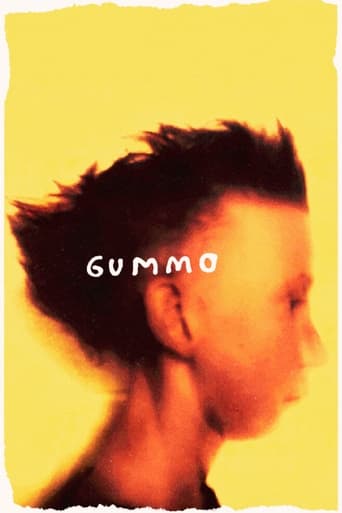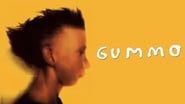Cody Gearheart
Harmony Korine's feature debut suffered very harsh criticism when it was released due to it's non-linear storyline, non-professional actors, frequent use of different unusual cameras, shoestring budget, and an array of several different disturbing topics that seem quite disjointed and sordid. The movie itself is not for all tastes mainly because it deals not only with the breakdown of a town, but because it's about how not every place in the USA is an American dream and how poverty, boredom, abuse, death, loneliness, disaster, and a lack of healthy relationships can complete destroy and desensitize a whole community and turn them into a band of crazies. The film is a moving and unpolished tapestry of broken lives and the random insanity that occurs in those portraits.
Tromafreak
Trash cinema comes in many forms. Funny, shocking, confusing, offensive, scary. And then there's Gummo, which, I guess, is a mixture of all that, and also, just plain pointless. But hey. Not all movies need a point to be entertaining, or to gain a cult following. A fact which makes writer/director, Harmony Korine a very lucky man. Because, even after watching his masterpiece (?), I'm still not convinced this guy has all that much talent. But he does have some pretty unique stuff going on in his head. And above all, that's what Gummo is. Whether it's a good movie or not is debatable, but let's just go with unique at the moment.About a town full of backwards, hateful dicks who have simply given up on ever being anything. A bad tornado hit this town some years ago, and things were seemingly never fully restored. Ignorant, aimless and bored, these hateful dicks love killing and torturing cats, running their mouths about nothing, getting it on with retards and just hanging around and being trash. Some of them get in fights with chairs. Some of them even win. Hell, some of them enjoy eating spaghetti whilst getting their hair washed. But I don't think any of them are very happy people. And they'd probably prefer to live somewhere else, but are too lazy and stupid to take the steps to do so.The movie seems to revolve mostly around some ugly little pussy kid who's probably an ass hole, yet, we don't get very many examples of this. The kid pumps iron, using handfuls of spoons, and apparently needs his mother to bath him. There's also some other little weirdo kid, wearing a pink bunny hat, and wandering around in his own little world. I'm not sure what he symbolizes, if anything, but like everyone else, he's just there, existing. Despite everything I've said so far in this paragraph, There's something very real about this movie. And surreal at the same time. It almost comes off as some kind of bleak documentary about a small town full of trash, where a bunch of stuff happens.As a lifelong cat lover, I find it hard to watch a cat get hurt or killed, even in a movie. But strangely, I see the treatment of felines in Gummo as somewhat fitting for the characters, as they just naturally feel the need to bully and destroy the only thing they see as beneath them. Adding to this perfect portrayal of hateful, pathetic trash.After despising the abomination that is Spring Breakers, I thought I'd give Harmony Korine one more chance to prove himself not a talentless POS. And much to my surprise, I'm glad I did. I think I actually get Gummo, and even have an appreciation for it. However, I could easily see someone hating this as much as I hated the obnoxious Spring Breakers, because one thing Gummo (and Spring Breakers as well) is not is a likable movie. Seemingly no story, with just a bunch of random scenes put together, showcasing these hopeless citizens and their attempts at killing time and, I guess, having fun. But if you look a little closer, it's clear that these people's behavior tells the story. loud and clear. And it's not a pretty one. Of course, this is not the most entertaining movie I've ever seen, but I'll give Korine one thing. Gummo is far more entertaining than it should be. 6/10
Catrician
1994 is oftentimes considered to be one of the best years for cinema, by both casual viewers, cinephiles, and hardcore film history buffs alike. We received films that would please all audiences; Zemeckis' "Forrest Gump", Tarantino's "Pulp Fiction", Kieslowski's "Three Colours: Red", Burton's "Ed Wood", Tarr's "Satantango", the list goes on. As such, it's easy to pass over a film that came out that year which, in reality, was quite influential, more so than some of the previously mentioned movies. That film was Clark's "Kids" (IMDb has it listed as 1995, but it premiered at film festivals in '94). While it was met with mixed reviews at the time (and mixed reviews now), it was seen as one of the first films that really had this bold statement about American youth, and that was that so many of them were these sex-addicted, hopeless stoners with meaningless lives. While Larry Clark directed this, Harmony Korine, 19 at the time, wrote the script and had a major influence on the film. Van Sant (whose film "Elephant", as I stated previously, makes him a more than capable director) cited that Korine would be "the face of postermodern American directors", and Werner Herzog ("Aguirre: The Wrath of God") also gave similar praises. The partial writer for one film, however, doesn't get such praises. A mere three years later, Korine released what is known now to be one of the most unsettling, disturbing, and downright unusual films in the form of Gummo. Surprisingly enough, the critical reaction for Gummo has been worse than that of "Kids". A possible explanation for this is that "Kids" is simply more viewer-friendly. Any 30+ year old film buff with a decent taste could probably watch "Kids" and at least get a bit of perspective, while maybe questioning the youth of the nation.Gummo doesn't have any questions to ask though. It's more of a work of art that is absolutely disgusting to look at, yet fascinating in every way. So, for a comparison, it would be like if Van Gogh crashed two cars together at exactly 39.4 miles per hour, with them perpendicular to one another, with no wind in the air. It might seem pointless at first, but you may need to look a bit closer to truly analyze the themes of Gummo.The opening scenes describe how a tornado has destroyed the town of Xenia, Ohio, and we then begin viewing the residents of the town trying to find meaning in their pointless, hopeless, and overall miserable lives.Korine stated once that about 75% of Gummo was scripted. Upon rewatching the film, I can hardly determine where the realism starts and where the fiction ends. I've often times commended directors for having a sort of "surrealism realism" as Von Trier did so magically with his masterpiece "Dogville", and Korine takes it to a whole new level. The documentary feel adds to the film spectacularly because it forces the viewer to confront reality: that, somewhere in the world, there are people who behave as the characters in Gummo do.Even the name of Gummo is symbolic in a few ways. The name "Gummo" is named after the oldest of the Marx brothers, who were notable for their anarchist comedy, which Gummo is to some extent. However, the oldest Marx Brother never appeared on camera; he was always more indirectly involved with cinema. Korine, here, is stating that Gummo is something new; something cinema has literally never seen before, even if it has seen its "relatives" ("Kids" possibly?)There are a number of assumptions that reviewers make when discussing the film; I'm not suggesting any of these are right or wrong, but they do exist. Some suggest that the town is made up of Satanists, which is how they are able to live in a near trance-like state throughout the film and simply accept the horrors of their lives. These conclusions are most likely also drawn from the images of self harm used in the film, as well as heavy metal taking up a good portion of Gummo's soundtrack. Other say that the film is a more real-life portrait of a post- apocalyptic scenario, stripping man down to his bare bones and showing what he really is. Curiously, only a single character in Gummo is shown to have any pathos attached to him whatsoever. This character is Tummler, who is seen to feel overwhelming depression in the film as it leaks over into the audience at times. It's not even sadness about poverty, or loneliness, but rather a state of hatred for anything and everything, the feeling of wanting to be dead, or at the very least have something to give life meaning.Gummo hits the audience over the head repeatedly with its horrors of this small town wasteland. Teens addicted to sniffing glue, teens buying down-syndrome prostitutes, teens making a competition over who can kill the most cats to sell to a local restaurant, etc. Although his approach is heavy-handed, it has an artistic purpose: some people live like this, and Korine is letting us see within his mind for an hour and a half. There are parts which are nearly impossible to watch, but the film has this unusually captivating "feel" to it, which is enhanced by the incredible cinematography.It's not easy to watch, it's not fun to watch, and it is also incoherent at times. The comparison could be made that watching Gummo is like reading about the Holocaust; neither are fun to watch, and the imagery is nauseating at times, yet many people are fascinated by it, not in a sadistic sense of the word, but merely fascinated by the fact that it happened. I'm amazed that a film like Gummo was made, yet I'm satisfied with its existence.
Camoo
Gummo is perhaps the greatest manifestation of Korine's bizarre view from the trench he's dug for himself - a loose, dark and poetic work with a nihilistic bent and an unending cast of interesting characters, though 'interesting' is too easy a descriptor .. Lost, damaged, deformed, hurt, strange, weak, strong, isolated.. Though always human. A film like this is easy to dismiss but not easy for an ordinary Joe like me to imagine being made. How does he find these people? Where are these places? How come I've never seen this side of America before? What Korine does very very well is present a side of life that you don't get to see very often -particularly in the movies. Gummo, to most, might as well have been shot on Mars. It has stayed with me since I first saw it years ago - the images are impossible to forget. I watch it now and though some of the film pains me to watch, and despite the fact that I'm unable to ever fully embrace the awful/awesome creatures that populate it, I can't shake it. Very unique and unsettling work.





